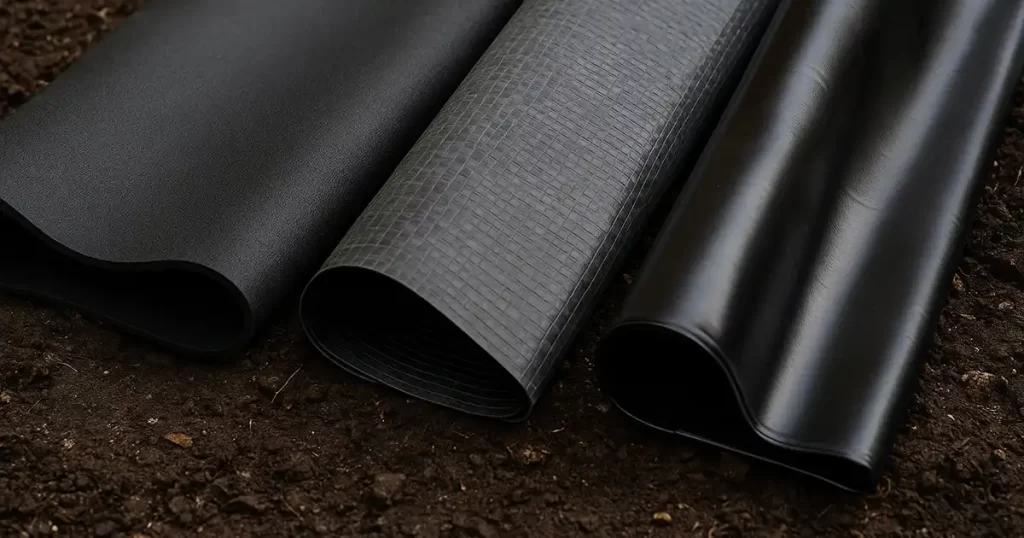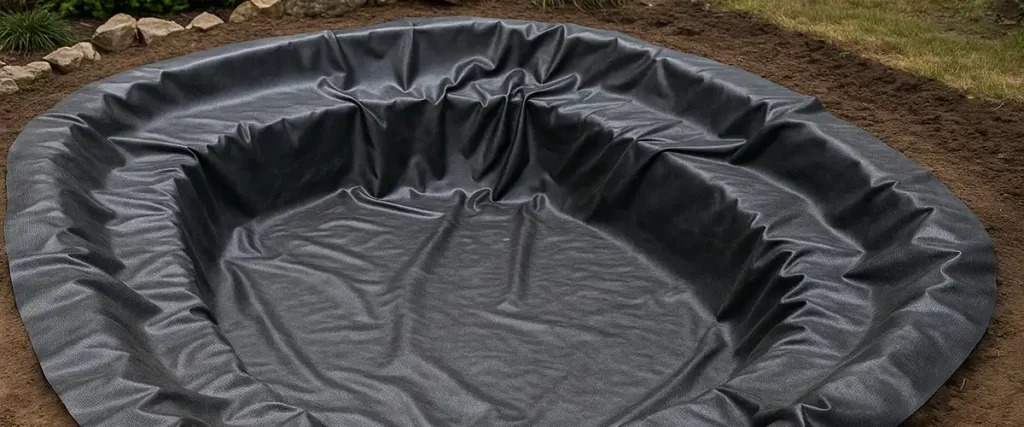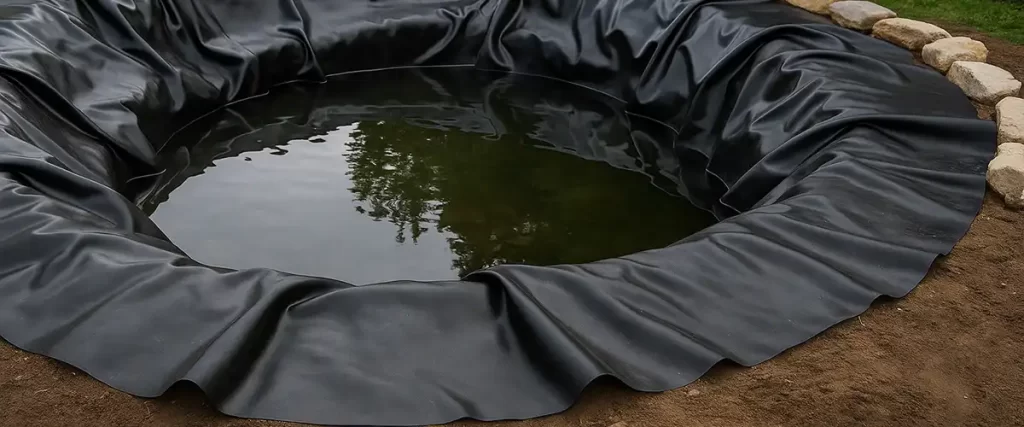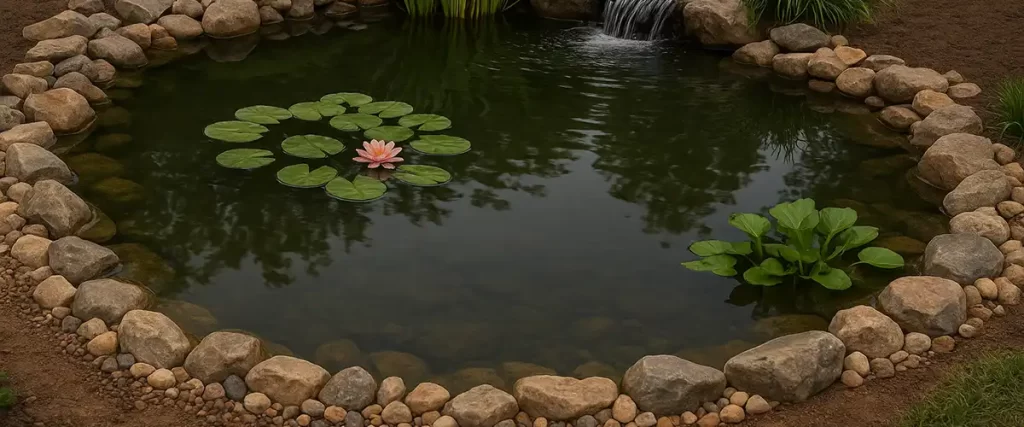
Building a pond begins with selecting the right liner. The material you choose determines how well the pond holds water, how protected the fish and plants are, and how much maintenance the pond may require over time.
There are several types of liners available, including EPDM, PVC, RPE, HDPE, preformed shells, and concrete. Each option varies in flexibility, cost, durability, and ease of installation.
Some liners are built for long-term performance. Others may be more cost-effective at the start but require more frequent upkeep. The right material depends on the pond’s design, location, and how it will be used.
What Makes a Good Pond Liner Material?
Before we get into specific types, let’s talk about what qualities actually matter when picking a liner.
A good pond liner should be:
- Durable and puncture-resistant. Tree roots, shifting rocks, or even small animals can damage liners that aren’t made to hold up.
- UV resistant. Sunlight can degrade some materials over time. A liner exposed to direct sunlight needs to resist UV rays.
- Flexible. If you’re shaping a custom garden pond or installing around curves and shelves, flexibility makes the installation much smoother.
- Safe for fish and plants. Not all liners are non-toxic. For koi ponds and water gardens, this is non-negotiable.
- Long-lasting. A good liner should serve you for years, if not decades.
Choosing the Best Pond Liner for Your Project
There’s no single best pond liner for every situation. Each material comes with tradeoffs.
- EPDM rubber: Great flexibility, fish safe, long lifespan, heavier and more expensive than others
- RPE: Strong, light, puncture resistant, less flexible than rubber
- PVC: Low cost, easy to install, not ideal for full sun or cold climates
- Butyl: Similar to EPDM, usually more expensive
- Preformed: Fast install, but limited shape and prone to cracking over time
- HDPE: Best for large, commercial applications
- Concrete: Durable but prone to cracking, time consuming to install and maintain

1. EPDM Rubber Pond Liners
EPDM (ethylene propylene diene monomer) rubber liners are one of the most popular choices for both small backyard water gardens and large koi ponds.
Why? Because they check almost every box.
EPDM rubber is flexible, making it ideal for custom pond shapes or complex water features. It’s highly UV-resistant, meaning it can handle years of sunlight without breaking down. EPDM liners are also safe for fish, plant-friendly, and easy to work with during installation.
They’re thick, typically around 45 mil, but they stretch slightly, which makes them forgiving during installation and less likely to tear if the ground shifts or rocks press against the liner.
That said, EPDM liners aren’t the lightest. They can be heavy and somewhat time-consuming to install on your own, especially for larger ponds. And while not the most expensive option, they aren’t the cheapest either. Still, for many pond owners, EPDM rubber pond liner is the go-to material.
2. RPE Liners (Reinforced Polyethylene)
RPE liners offer a balance between durability and weight. They’re often used in larger ponds, reservoirs, or commercial water features. RPE is puncture-resistant, UV stable, and can be half the thickness of an EPDM liner while still being incredibly strong.
Because of their strength-to-weight ratio, RPE liners are easier to transport and install than thicker rubber liners. They’re also extremely resistant to stretching, which helps prevent sagging or leaks over time.
One drawback? RPE isn’t as flexible as EPDM, which means shaping it around tight corners or uneven shelves takes more effort. And while they can last a long time, they may not hug irregular pond contours quite as well as a rubber liner can.
3. PVC Pond Liners
PVC liners are budget-friendly, lightweight, and easy to install. If you’re looking for a low-cost option to line a small pond or water feature, this might sound appealing.
But there are a few things to be cautious about.
PVC is less durable than EPDM or RPE. It’s also more prone to cracking in colder temperatures and tends to break down under prolonged UV exposure. Especially if the liner isn’t buried or shaded.
For ponds in full sun or areas with temperature extremes, a PVC pond liner might not be the best long-term solution.
Some PVC liners are not fish-safe either. So if you’re building a koi pond or keeping aquatic plants, make sure the liner you’re using is rated for pond life.
Still, for temporary installations or simple garden ponds, PVC liners remain a common choice.

4. Butyl Rubber Liners
Butyl pond liners were once a popular premium option. But in many cases, EPDM has taken over as the modern replacement.
Butyl is also a synthetic rubber, known for its flexibility and durability. It performs similarly to EPDM, though typically at a higher price point. It’s still used in some applications, but for most homeowners and landscape professionals, EPDM offers a better cost-to-performance ratio.
If you’re restoring an older pond or replacing a liner in a formal garden built years ago, you might come across butyl. For new builds, though, EPDM usually makes more sense.
5. Preformed Pond Liners
These rigid liners are molded plastic shells that come in set shapes and sizes. They’re easy to install and great for beginner DIY pond projects. You simply dig a hole that matches the shape, place the liner in it, and level it.
But the convenience has limits.
- Less flexibility: You’re stuck with the shape you buy.
- Challenging repairs: Cracks in preformed liners are harder to patch than flexible liner materials.
- Size constraints: They’re usually small, which makes them better suited for decorative water gardens than full koi ponds.
Still, for someone who wants a quick pond setup in a small garden, a preformed pond liner can be a practical start.
6. HDPE and Concrete Options
High-density polyethylene (HDPE) liners are used in larger commercial or industrial applications. They’re extremely durable and puncture-resistant, but less flexible than other options. Not ideal for smaller, organically shaped garden ponds, but well-suited for larger bodies of water.
Concrete ponds also exist, but they require significantly more labor and long-term maintenance. Cracks are common, and sealing them can be a recurring job. While concrete gives a permanent structure, it lacks the flexibility and ease of repair found in other liners.

Underlayment and Installation Considerations
No matter what pond liner material you choose, what’s underneath matters just as much.
A geotextile underlay or even an old piece of carpet or sand base helps protect the liner from sharp rocks, roots, and shifting soil. Skipping this step is one of the fastest ways to end up with punctures or leaks.
When installing, take your time shaping the pond. Don’t stretch the liner too tight. Use smooth rocks or edging material to hold it in place, and leave enough liner over the edges in case of settling.
Wondering how much liner you need? A simple formula is:
Pond length + (2 × depth) + 2 feet = liner length
Pond width + (2 × depth) + 2 feet = liner width
That gives you enough to work with, plus a little extra just in case.
Thinking About Building a Pond, But Don’t Want the Hassle?
Pond building involves a wide range of decisions. From selecting the best material for a pond liner to making sure it’s protected from rocks, roots, and shifting soil. All of that comes before adding water or introducing fish.
If managing those steps feels overwhelming, you can hand it off to someone with the experience to do it right.
Call us at (407) 480-0713 or message us here to talk about your pond building project.
Frequently-Asked Questions
1. What’s the best material for pond liner?
The best material for a pond liner depends on your pond size, budget, and design. EPDM rubber and RPE liners are top choices for most ponds because they’re durable, flexible, and safe for fish. EPDM works well for custom shapes, while RPE is stronger and lighter for large ponds.
2. What’s the most durable pond liner material?
EPDM rubber and RPE liners are among the most durable options. Both can last 20 years or more with proper installation and care. RPE offers excellent puncture resistance, while EPDM provides flexibility for irregular pond shapes.
3. Which pond liner is safest for fish and plants?
EPDM and RPE liners are both fish-safe and non-toxic. Always check the manufacturer label to confirm the liner is rated for aquatic life, since some PVC liners may contain additives that can harm fish or plants.
4. What’s the easiest pond liner to install for beginners?
Preformed pond liners are the easiest for DIY installations. You simply dig the hole to match the shape, drop in the liner, and level it. For flexible liners, PVC is the easiest to handle, while EPDM requires a bit more effort but lasts longer.
5. How long do pond liners usually last?
Lifespan depends on the material and exposure. PVC liners last around 10 years, RPE can last 20–25 years, and EPDM often exceeds 25 years with proper underlayment and maintenance.
6. Do I need an underlayment under the pond liner?
Yes. A protective underlayment such as geotextile fabric, sand, or even old carpet prevents punctures from rocks or roots. It’s one of the most important steps for long-term liner protection.
7. Can pond liners crack in the sun or cold weather?
PVC liners can crack or become brittle under direct sunlight or freezing temperatures. EPDM and RPE liners, however, are UV-resistant and remain flexible in a wide range of climates.
8. Is concrete a better option than a pond liner?
Concrete ponds are permanent and durable but expensive and prone to cracking over time. Flexible liners like EPDM or RPE are easier to install, maintain, and repair, making them better suited for most backyard ponds.
